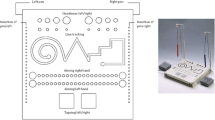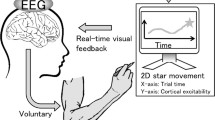Abstract
Functional magnetic resonance imaging was used to characterize patterns of cortical activation in response to sensory and motor tasks in patients with writer’s cramp. 17 patients and 17 healthy subjects were examined during finger-tapping, index finger flexion, and electrical median nerve stimulation of both hands during electromyographic monitoring. SPM2 was used to evaluate Brodmann area (BA) 4, 1, 2, 3, 6, 40. Patients showed decreased activation in the left BA 4 with motor tasks of both hands and the left BA 1–3 with right finger-tapping. With left finger-tapping there was bilateral underactivation of single areas of the somatosensory cortex. Patients exhibited decreased activation in the bilateral BA 6 with left motor tasks and in the right BA 6 with right finger-tapping. Patients had decreased activation in bilateral BA 40 with finger-tapping of both hands. The findings suggest decreased baseline activity or an impaired activation in response to motor tasks in BA 1–4, 6, 40 in patients with writer’s cramp for the dystonic and the clinically unaffected hand.





Similar content being viewed by others
References
Albanese A (2003) The clinical expression of primary dystonia. J Neurol 250:1145–1151
Chen R, Hallett M (1998) Focal dystonia and repetitive motion disorders. Clin Orthop Relat Res June(351):102–106
Marsden CD, Sheehy MP (1990) Writer’s cramp. Trends Neurosci 13:148–153
Berardelli A, Rothwell JC, Hallett M et al (1998) The pathophysiology of primary dystonia. Brain 121(Pt 7):1195–1212
Elbert T, Candia V, Altenmuller E et al (1998) Alteration of digital representations in somatosensory cortex in focal hand dystonia. Neuroreport 9:3571–3575
Sanger TD, Merzenich MM (2000) Computational model of the role of sensory disorganization in focal task-specific dystonia. J Neurophysiol 84:2458–2464
Bara-Jimenez W, Catalan MJ, Hallett M, Gerloff C (1998) Abnormal somatosensory homunculus in dystonia of the hand. Ann Neurol 44:828–831
Sheehy MP, Marsden CD (1982) Writers’ cramp-a focal dystonia. Brain 105(Pt 3):461–480
Odergren T, Stone-Elander S, Ingvar M (1998) Cerebral and cerebellar activation in correlation to the action-induced dystonia in writer’s cramp. Mov Disord 13:497–508
Oldfield RC (1971) The assessment and analysis of handedness: the Edinburgh inventory. Neuropsychologia 9:97–113
Diem K, Lentner C (1973) Scientific tables, 7th edn. Chiba-Geigy Limited, Basle, p 131
Preibisch C, Berg D, Hofmann E et al (2001) Cerebral activation patterns in patients with writer’s cramp: a functional magnetic resonance imaging study. J Neurol 248(1):10–17
Nakai T, Matsuo K, Kato C et al (2001) BOLD contrast on a 3 T magnet: detectability of the motor areas. J Comput Assist Tomogr 25:436–445
Arunachalam R, Weerasinghe VS, Mills KR (2005) Motor control of rapid sequential finger tapping in humans. J Neurophysiol 94(3):2162–2170
Fogassi L, Gallese V, Buccino G et al (2001) Cortical mechanism for the visual guidance of hand grasping movements in the monkey: a reversible inactivation study. Brain 124:571–586
Cerri G, Shimazu H, Maier MA, Lemon RN (2003) Facilitation from ventral premotor cortex of primary motor cortex outputs to macaque hand muscles. J Neurophysiol 90(2):832–842
Binkofski F, Dohle C, Posse S et al (1998) Human anterior intraparietal area subserves prehension: a combined lesion and functional MRI activation study. Neurology 50(5):1253–1259
Tempel LW, Perlmutter JS (1990) Abnormal vibration-induced cerebral blood flow responses in idiopathic dystonia. Brain 113(Pt 3):691–707
Tempel LW, Perlmutter JS (1993) Abnormal cortical responses in patients with writer’s cramp. Neurology 43:2252–2257
Oga T, Honda M, Toma K et al (2002) Abnormal cortical mechanisms of voluntary muscle relaxation in patients with writer’s cramp: an fMRI study. Brain 125:895–903
Ibáñez V, Sadato N, Karp B et al (1999) Deficient activation of the motor cortical network in patients with writer’s cramp. Neurology 53(1):96–105
Pujol J, Roset-Llobet J, Rosines-Cubells D et al (2000) Brain cortical activation during guitar-induced hand dystonia studied by functional MRI. Neuroimage 12:257–267
Deuschl G, Toro C, Matsumoto J, Hallett M (1995) Movement-related cortical potentials in writer’s cramp. Ann Neurol 38:862–868
Ridding MC, Sheean G, Rothwell JC et al (1995) Changes in the balance between motor cortical excitation and inhibition in focal, task specific dystonia. J Neurol Neurosurg Psychiatry 59:493–498
Chen R, Wassermann EM, Canos M, Hallett M (1997) Impaired inhibition in writer’s cramp during voluntary muscle activation. Neurology 49:1054–1059
Siebner HR, Tormos JM, Ceballos-Baumann AO et al (1999) Low-frequency repetitive transcranial magnetic stimulation of the motor cortex in writer’s cramp. Neurology 52:529–537
Lerner A, Shill H, Hanakawa T, Bushara K, Goldfine A, Hallett M (2004) Regional cerebral blood flow correlates of the severity of writer’s cramp symptoms. Neuroimage 21(3):904–913
Penniello MJ, Lambert J, Eustache F et al (1995) A PET study of the functional neuroanatomy of writing impairment in Alzheimer’s disease. The role of the left supramarginal and left angular gyri. Brain 118(Pt 3):697–706
Kupsch A, Benecke R, Müller J et al (2006) Pallidal deep-brain stimulation in primary generalized or segmental dystonia. N Engl J Med 355(19):1978–1990
Author information
Authors and Affiliations
Corresponding author
Rights and permissions
About this article
Cite this article
Islam, T., Kupsch, A., Bruhn, H. et al. Decreased bilateral cortical representation patterns in writer’s cramp: a functional magnetic resonance imaging study at 3.0 T. Neurol Sci 30, 219–226 (2009). https://doi.org/10.1007/s10072-009-0045-7
Received:
Accepted:
Published:
Issue Date:
DOI: https://doi.org/10.1007/s10072-009-0045-7




